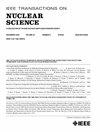A Prototype Gamma Imaging System for Measuring High-Intensity Proton Beam Spots Based on Pixelated CdZnTe Detectors
IF 1.9
3区 工程技术
Q3 ENGINEERING, ELECTRICAL & ELECTRONIC
引用次数: 0
Abstract
Measuring the high-power proton beam distribution on the target is critical for the stable operation of a spallation neutron source or an accelerator-driven subcritical system (ADS). This work preliminarily implemented a step of a proposed methodology for indirectly measuring the proton beam spot using pinhole imaging by detecting back-streaming secondary gammas. A prototype gamma imaging system based on pixelated cadmium zinc telluride (CdZnTe) detectors was developed to serve as a foundation for implementing the proposed method. Each detector consists of an求助全文
约1分钟内获得全文
求助全文
来源期刊

IEEE Transactions on Nuclear Science
工程技术-工程:电子与电气
CiteScore
3.70
自引率
27.80%
发文量
314
审稿时长
6.2 months
期刊介绍:
The IEEE Transactions on Nuclear Science is a publication of the IEEE Nuclear and Plasma Sciences Society. It is viewed as the primary source of technical information in many of the areas it covers. As judged by JCR impact factor, TNS consistently ranks in the top five journals in the category of Nuclear Science & Technology. It has one of the higher immediacy indices, indicating that the information it publishes is viewed as timely, and has a relatively long citation half-life, indicating that the published information also is viewed as valuable for a number of years.
The IEEE Transactions on Nuclear Science is published bimonthly. Its scope includes all aspects of the theory and application of nuclear science and engineering. It focuses on instrumentation for the detection and measurement of ionizing radiation; particle accelerators and their controls; nuclear medicine and its application; effects of radiation on materials, components, and systems; reactor instrumentation and controls; and measurement of radiation in space.
 求助内容:
求助内容: 应助结果提醒方式:
应助结果提醒方式:


